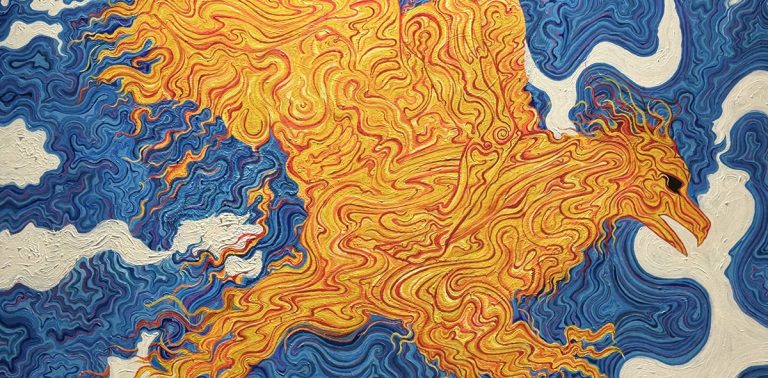Frederick Haddox, an expressionist originally from the U.S. and now based in Budapest, Hungary, creates narratives grounded in color, line, and form, moving beyond traditional composition. His art focuses on harmonizing animal and human forms, with a unique emphasis on their vibrational energy. Through this approach, Haddox draws viewers into a world where the dynamic flow of color and form communicates deeply resonant stories that capture the essence of shared energies and experiences. Inspired by the cultural landscape of Budapest, his work continues to evolve, reflecting the intersection of natural and human vibrancy.

Exploring “Phoenix Landing”
In Phoenix Landing, Haddox brings this artistic philosophy to life on a large scale, filling a 100×125 cm acrylic canvas with symbolic intensity. The piece reimagines the traditional phoenix myth, focusing not on rebirth but on a moment of transformative descent. Instead of a violent demise, the phoenix’s flames gradually lose their intensity as it lands, representing persistence rather than destruction. This moment becomes a testament to human resilience, suggesting that after overcoming opposition and struggle, one carries the essence of that hard-won power within.
Phoenix Landing explores the friction between opposing energies—transformed here into fire—without succumbing to an end. The work reflects Haddox’s belief in resilience and the powerful transformation that struggle can inspire. Here, the descent of the phoenix symbolizes an achievement of inner strength and calm rather than a simple rise-and-fall narrative. It’s this subtle nuance—the landing instead of a collapse—that makes the piece a striking metaphor for the tenacity found within the human spirit.
Color, Form, and Vibrational Energy
Color is fundamental in Phoenix Landing, where Haddox uses reds, oranges, and yellows to express the phoenix’s vibrant energy. These colors interact dynamically, often clashing in a way that suggests both struggle and unification. Haddox’s abstract composition allows color and line to dominate, removing rigid boundaries and letting colors flow into one another. This choice creates a sense of fluidity that mirrors the energy of the phoenix, reflecting how resilience and strength are forces that can’t easily be confined.
Haddox’s work merges animal and human forms through brushstrokes that suggest shapes without explicitly defining them. Hints of wings or limbs emerge, yet they remain subtly indistinct, letting the painting’s energy speak louder than any specific anatomy. This blurred approach encourages viewers to feel the vibrational energy shared between human and animal, a universal thread that Haddox believes connects all living forms. Through this fusion, the painting invites a sensory experience, a space where color and energy resonate on an instinctual level.
The Symbolism of Transformation
In Phoenix Landing, transformation takes center stage, yet it’s portrayed as a gradual, empowered process rather than a dramatic rebirth. Haddox’s interpretation of the phoenix myth captures the strength found in enduring challenges rather than focusing solely on renewal. The moment when the phoenix’s flames subside is portrayed as a powerful descent, a journey through friction toward something grounded and internalized.
Haddox’s work suggests that overcoming adversity leaves a lasting imprint on one’s energy and spirit, transforming struggles into resilience that shapes personal growth. The phoenix, now descending, becomes an emblem for the inner power that remains after pushing through challenges. Phoenix Landing reflects this journey, resonating as an image of strength that stays with us even after friction subsides. Through the phoenix, Haddox reminds viewers that breakthrough moments can be quiet yet deeply significant, with endurance becoming a part of one’s core essence.
Engaging the Viewer Through Abstract Narrative
Haddox’s approach to expressionism leans heavily on abstract narrative, bypassing rigid compositions in favor of color and movement that invite open interpretation. In Phoenix Landing, this approach allows the painting to shift in meaning with each viewing. The abstract forms and layered imagery give viewers the freedom to see new details or shapes each time—a suggestion of a wing, a flicker of intense orange, or even a shadow that takes on new significance.
Focusing on “vibrational energy” as a core element, Haddox presents an abstract but universally accessible narrative. The shared energy between human and animal, represented through the phoenix, opens a dialogue on resilience, encouraging viewers to find their own emotional responses. In this way, Phoenix Landing becomes more than a painting; it’s an experience, prompting viewers to reflect on personal growth and the lingering strength that past challenges have instilled within them.
A Harmonious Blend of Energy and Form
Frederick Haddox’s Phoenix Landing is an evocative exploration of harmony within friction, resilience within struggle, and the continuous flow of energy through form. His focus on vibrational energy connects animal and human experiences, drawing viewers into a narrative that reflects shared aspects of life’s journey. His work serves as a reminder that even as one descends, carrying the weight of past experiences, the strength gained remains within. Through Phoenix Landing, Haddox invites viewers to experience art as a means of tapping into those unseen energies that bind us, illustrating that art can serve as both reflection and renewal.

